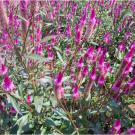This poster is from the project "Increasing production of indigenous African leafy vegetables," led by Stephen Weller, Purdue University. Other collaborators include Maria I. Marshall, Purdue University; Mathieu Ngouajio, Michigan State University; Dharma Pitchay, Tennessee State University; Pamela Obura, Naman Nyabinda, USAID/AMPATH; Elizabeth Omami, Julius Ochuodho, and Grace Cheserek, Moi University; Christine Ndinya, KARI; and Chris Ojiewo, AVRDC World Vegetable Center.
This poster contains information on this project including goals, objectives, activities and outcomes.
Introduction: "Our shovel ready project was designed to allow enhanced production, utilization and marketing of African leafy vegetables in Western Kenya by AMPATH clients. This was accomplished through evaluation of improved germplasm of African leafy vegetable species including: spider plant (Cleome gynandra), African nightshades (Solanum scabrum/S. villosum/S. americanum/S. tarderomotum) and amaranths (Amaranthus blitum/A. dubius/A. hybridus /A. spinosus). Indigenous African leafy vegetables were targeted because they contain higher levels of nutrients than commonly grown exotic species like Swiss chard, kale and cabbage, are rich in proteins (17.4-38.3% of dry matter), carbohydrates, vitamins and minerals and have medicinal properties. These vegetables are popular in Kenyan cultural diets and there is excellent potential for increased production and use in areas of traditional culture, however, constraints to greater production and marketing exist."
Goal: Establish a base of information and experience for greater production and use of indigenous vegetables to provide a source of food for economic security, improved health and nutrition for Kenyans, especially women farmers, children and those afflicted with HIV/AIDs.
Objectives:
- Assess genetic resources of African leafy vegetables for Kenya
- Improve African leafy vegetable seed system availability to Kenyan stakeholders
- Develop and disseminate improved horticultural practices and postharvest technologies for African leafy vegetables
- Develop marketing strategies for African leafy vegetables
- Promote educational programs on African leafy vegetables for farmers and other community groups
Activities:
- Household and market survey on African leafy vegetable production and marketing
- Germplasm evaluation
- Agronomic training (agronomic practices, agribusiness skills, group dynamics and management, group integrated saving and empowerment)
- Farmer field days
- Farmer planting and cultivar evaluation
- Seed handling training
- End of program evaluation survey ("Prior to our program, only 43% were growing ALVs but after intervention this increased to 90%")
Findings from the household and market survey on African leafy vegetable production and marketing:
- 70% of households are female headed and 87% of vendors were female.
- Key findings:
- 89% had major income from farming
- 47% grew nightshade, 11% grew amaranth, 7% grew spider plant and 33% grew all 3 African leafy vegetables
- African leafy vegetable income pays for food, household supplies and school fees
- African leafy vegetable seed is obtained from local sources (39%), saved seed (43%), AMPATH donated (7%) and from friends or other sources (10%)
- African leafy vegetables help supply food for the immediate family and excess African leafy vegetables are sold on farm to neighbors or at local markets
- Local market improvements
- Better display facilities and special areas for African leafy vegetable sales
- Better access to price information
Impacts:
- Farmer numbers affected
- Individual farmers (12) and farmer groups (10) trained in African leafy vegetable production and handling
- Individual Farmers: Eldoret – 5, Burnt Forest – 7, Farmer groups: Busia – 4; Khunyangu – 3; Chulaimbo – 3; with a total direct impact on 285 farmers.
- Improved seed varieties for farmers
- Improved plant productivity
- Better yield and quality
- Improved flavor of new AVRDC cultivars compared to local varieties
- Most farmers had no knowledge improved varieties of African leafy vegetables existed
- Production practices
- New planting techniques: use of beds, planting in rows, appropriate seeding rates, fertilizer timing, sequence planting, thinning and transplanting
- Food and Nutrition Security
- Increased awareness among communities on nutritional and potential economic benefits of African leafy vegetables
- Institutional Collaboration
- Avenues for collaboration between AMPATH, Moi, KARI and U.S. partners
- Indirect spillover of African leafy vegetable cultivar improvements and agronomic training with neighbors and communities
- African leafy vegetable farmers gained new customers and increased community respect
The presentation also includes project next steps and future questions to ponder.

